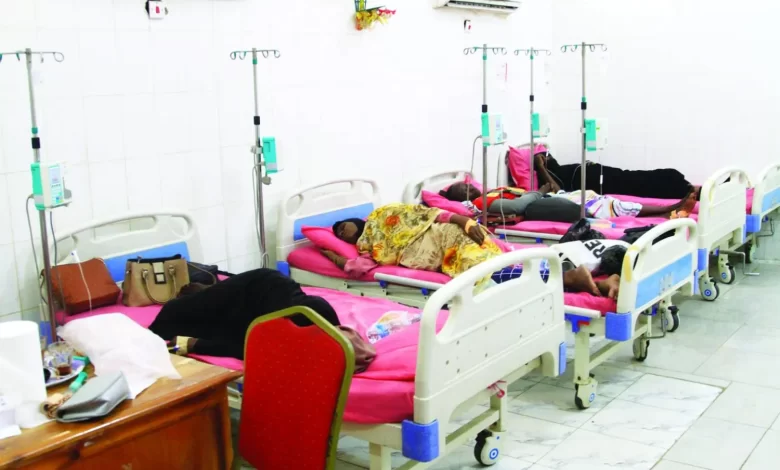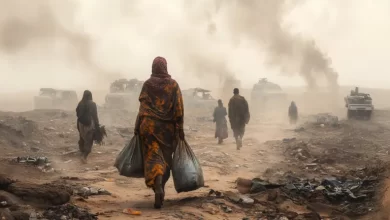Sudan’s War Fuels Cholera Outbreak

The ongoing war in Sudan, which has lasted for more than two years and caused widespread destruction to the environment, electricity stations, and drinking water purification facilities, has led to the outbreak of a cholera epidemic. More than 3,000 people have been infected, and over 50 have died in several neighborhoods of the capital Khartoum and other states across the country.
The most affected areas include Jebel Aulia in southern Khartoum and Karari locality in northern Omdurman. Media reports suggest that the actual numbers of infections and deaths are significantly higher than official figures.
Health Minister Haitham Mohamed Ibrahim told Asharq Al-Awsat that cholera cases have reached 3,049 in Khartoum localities, with 57 deaths, noting that the fatality rate is 1.9 percent. He added that the majority of cases were concentrated in Salha (south of Omdurman), Umbada (west Omdurman), as well as Jebel Aulia and Karari. The minister confirmed that the health authorities are holding morning and evening meetings to manage the crisis, and have formed an emergency task force that includes many organizations operating in Khartoum State.
The minister attributed the re-emergence of the epidemic, which first appeared three years ago, to poor health and environmental conditions in some areas, including shortages of clean drinking water and food. “When the epidemic first appeared three years ago, it was contained in several states through direct government interventions, supported by international organizations and UN agencies,” he said. Ibrahim revealed that water chlorination campaigns and cholera vaccination efforts are underway, stating, “Sudan has received more than 12 million cholera vaccine doses, which have been distributed to most affected states.”
700 Cases Weekly
The minister noted that the infection rate in Khartoum State has reached around 700 cases per week over the past four weeks. “In coordination with the state health authorities and eight international organizations and UN agencies, more than eight treatment centers have been opened. Health authorities are focusing on treatment, containment, and water disinfection, which is a major factor in the spread of the epidemic,” he said.
He expects case numbers to decline in the coming weeks as vaccination campaigns expand into previously unvaccinated localities. Donors have also agreed to supply additional vaccines for Khartoum State, support water disinfection campaigns, increase efforts from the water authority, and organize environmental sanitation initiatives.
The cholera outbreak is not limited to Khartoum. In the neighboring Gezira State, cases have also been reported. Local media said the rapid spread of cholera has led to the closure of schools and markets. In addition to cholera, the state is witnessing widespread outbreaks of malaria, dengue fever, and acute malnutrition—especially among children—due to the collapse of health infrastructure, a shortage of vital medical supplies, and deteriorating water, electricity, and sanitation services.
Médecins Sans Frontières (Doctors Without Borders) reported over 2,500 suspected cholera cases in Khartoum since early May. The organization said that 500 cases were reported on May 21 alone, describing the trend as a sharp escalation that requires an urgent response.
MSF attributed the epidemic to power outages in Khartoum and the lack of fuel needed to operate generators that power water stations and hospitals, severely affecting the ability of health facilities to provide necessary care and hampering containment efforts.
Contaminated Water
A witness from Karari locality in northern Omdurman reported that cholera had spread widely in the area. He said one of his neighbors died from the disease and that accessing clean drinking water has become unaffordable for most families, as most available water is now contaminated and a carrier of cholera. “The water pumping generator operates every two days, costing 2,000 Sudanese pounds per household,” he added.
Observers linked the epidemic to repeated power cuts caused by drone attacks on the country’s main power stations. They warned that the outbreak could worsen further since hospitals are no longer capable of handling the increasing number of cases. Meanwhile, social media users have circulated photos of isolation centers where patients are lying on the ground outside hospital rooms.
Previous reports from the Sudanese Ministry of Health indicated that total cases in the country had surpassed 60,000, with 1,617 deaths recorded across 88 localities in 12 of Sudan’s 18 states.
Starving to Death
On Saturday, the Sudanese Doctors Network announced that 13 people had died of hunger in the “Gaga” refugee camp for Sudanese in Chad over the past week. In a statement posted on Facebook, the network said: “Sudanese refugees in the Gaga camp in Chad are suffering catastrophic humanitarian conditions due to the lack of food and medicine, alongside the spread of disease. This is due to the international and humanitarian organizations’ neglect of the refugees and failure to provide them with sufficient food. Thirteen people have died of hunger in the past week, threatening the lives of thousands more.”
The network appealed to international and UN organizations to urgently provide food to the Sudanese refugees in the Gaga camp, which hosts 21,000 people, and to stop further forced displacement in search of food and medicine. The network expressed deep regret over the worsening conditions of Sudanese refugees in Chad and condemned the international community’s silence, stressing that what is happening exposes the excuses made by aid organizations regarding border crossings for delivering assistance, while thousands of displaced Sudanese continue to suffer in the camps.



